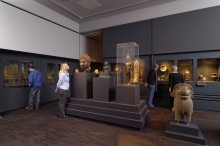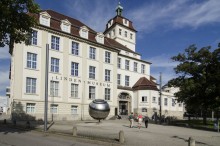Linden-Museum Stuttgart, Germany

 The exhibitions of the Linden-Museum invite to encounter the far-off peoples of this earth –a world trip under one roof. Collections on Africa, North America and Latin America, the Orient, South and East Asia and Oceania highlight the beauty and fascination of human cultures around the globe.
The Württemberg Association for Trade Geography established the museum, which was opened in 1911, as a space for its collections of evidence of art and everyday culture beyond European culture.
The Linden-Museum is named after the chairman of the association at that time, Karl Graf von Linden (1838 – 1910). Today the Linden-Museum is one of the largest museums of ethnology in Europe. The broad collections with precious pieces of international importance comprise around 160,000 items from all large cultural regions on the planet. The visitor can obtain a deep insight into art and cultural history right up to the present day, as well as learn about everyday culture.
The exhibitions of the Linden-Museum invite to encounter the far-off peoples of this earth –a world trip under one roof. Collections on Africa, North America and Latin America, the Orient, South and East Asia and Oceania highlight the beauty and fascination of human cultures around the globe.
The Württemberg Association for Trade Geography established the museum, which was opened in 1911, as a space for its collections of evidence of art and everyday culture beyond European culture.
The Linden-Museum is named after the chairman of the association at that time, Karl Graf von Linden (1838 – 1910). Today the Linden-Museum is one of the largest museums of ethnology in Europe. The broad collections with precious pieces of international importance comprise around 160,000 items from all large cultural regions on the planet. The visitor can obtain a deep insight into art and cultural history right up to the present day, as well as learn about everyday culture.
East Asia Collection
Outstanding exhibits from China and Japan bring the visitor closer to East Asian art and allow him to make a direct comparison of the two cultures. A Japanese tea house, a traditional living room, as well as paintings and applied arts introduce him to life in Japan. A variety of exquisite ceramic works hail from China, which show the development of Chinese pottery from the Neolithic period up to the 20th century. One treasure of the department's collection is its famous collection of lacquer, urushi, objects, some Chinese examples of which date back 2500 years. Ritual bronzes and the so-called „spirit objects“ familiarize with the world of Chinese ancestor worship and burial culture. The collection is completed with works of art from East Asian Buddhism.South and Southeast Asia Collection
The collections, which are among the topmost in European museums, comprise objects from India (including ancient Afghanistan), Sri Lanka, continental Southeast Asia and Java/Indonesia as well as Nepal and Tibet. Religious art objects from ancient times till the recent past enable visitors to overview the 2500 years of development and changes of the Hindu and Buddhist believes and rituals against their cultural/historic backgrounds in India and the neighbouring Asian countries. The recent spatial enlargement enabled to add topics like "Art and religion of the Jainas" (India), “Buddhist art of Myanmar” and "Cham"(Vietnam). The Himalaya section presents a selection of exceptional objects pertaining to Tibetan Buddhism, showing that its influence far exceeded the borders of Tibet itself, with Bhutan, Nepal, Mongolia, as well as some regions of Northern India and China significantly affected. Pictures above by Anatol Dreyer. Copyright Linden-Museum Stuttgart.View all Asia-Europe Museum Network (ASEMUS) members in Germany
Similar content
12 Feb 2016 - 14 Aug 2016
from - to
17 Dec 2011 - 03 Jun 2012
02 Oct 2015
posted on
25 Mar 2012
22 Nov 2014
posted on
29 May 2013
